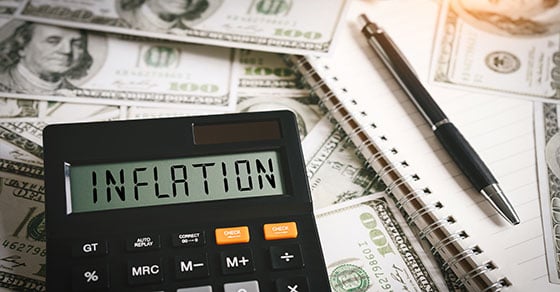

The effects of inflation are all around. You’re probably paying more for gas, food, health care and other expenses than you were last year. Are you wondering how high inflation will affect your federal income tax bill for 2023? The IRS recently announced next year’s inflation-adjusted tax amounts for several provisions.
Some highlights
Standard deduction. What does an increased standard deduction mean for you? A larger standard deduction will shelter more income from federal income tax next year. For 2023, the standard deduction will increase to $13,850 for single taxpayers, $27,700 for married couples filing jointly and $20,800 for heads of household. This is up from the 2022 amounts of $12,950 for single taxpayers, $25,900 for married couples filing jointly and $19,400 for heads of household.
The highest tax rate. For 2023, the highest tax rate of 37% will affect single taxpayers and heads of households with income exceeding $578,125 ($693,750 for married taxpayers filing jointly). This is up from 2022 when the 37% rate affects single taxpayers and heads of households with income exceeding $539,900 ($647,850 for married couples filing jointly).
Retirement plans. Many retirement plan limits will increase for 2023. That means you’ll have an opportunity to save more for retirement if you have one of these plans and you contribute the maximum amount allowed. For example, in 2023, individuals will be able to contribute up to $22,500 to their 401(k) plans, 403(b) plans and most 457 plans. This is up from $20,500 in 2022. The catch-up contribution limit for employees age 50 and over who participate in these plans will also rise in 2023 to $7,500. This is up from $6,500 in 2022.
For those with IRA accounts, the limit on annual contributions will rise for 2023 to $6,500 (from $6,000). The IRA catch-up contribution for those age 50 and up remains at $1,000 because it isn’t adjusted for inflation.
Flexible spending accounts (FSAs). These accounts allow owners to pay for qualified medical costs with pre-tax dollars. If you participate in an employer-sponsored health Flexible Spending Account (FSA), you can contribute more in 2023. The annual contribution amount will rise to $3,050 (up from $2,850 in 2022). FSA funds must be used by year end unless an employer elects to allow a two-and-one-half-month carryover grace period. For 2023, the amount that can be carried over to the following year will rise to $610 (up from $570 for 2022).
Taxable gifts. Each year, you can make annual gifts up to the federal gift tax exclusion amount. Annual gifts help reduce the taxable value of your estate without reducing your unified federal estate and gift tax exemption. For 2023, the first $17,000 of gifts to as many recipients as you would like (other than gifts of future interests) aren’t included in the total amount of taxable gifts. (This is up from $16,000 in 2022.)
Thinking ahead
While it will be quite a while before you have to file your 2023 tax return, it won’t be long until the IRS begins accepting tax returns for 2022. When it comes to taxes, it’s nice to know what’s ahead so you can take advantage of all the tax breaks to which you are entitled.

